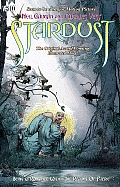
| Publisher: | Vertigo |
| Copyright: | 1997, 1998 |
| Printing: | 1998 |
| ISBN: | 1-56389-470-X |
| Format: | Trade paperback |
| Pages: | 223 |
Dunstan Thorn lives in the town of Wall in the English countryside. It's the time of Queen Victoria, Charles Dickens is still writing, and Wall is a quiet rural farming town a night from London. It's inhabitants, while going about their daily lives, guard the gap in the wall that gives the town its name. On the other side of the wall is Faerie. Once every nine years, on May Day, people come from all over the world to the town of Wall. The meadow beyond the gap in the wall fills with activity. And for a day everyone is allowed to go through the gap freely to the fair.
When he was eighteen, Dunstan Thorn went through to the fair looking for something pretty to buy for the woman he plans to propose to. Instead, due to a bargain that he makes with a strange visitor in search of lodging, he finds a beautiful woman kept slave by a witch, a glass flower, and his Heart's Desire.
Eighteen years later, at another fair, Tristran Thorn sees a falling star fall into Faerie, makes a rash promise to the woman he is courting, and sets off to find it and bring it back. Unbeknownst to him, the star is also coveted by a powerful witch and at the center of a struggle for succession. She's also hurt, scared, and rather annoyed.
This book started as a comic miniseries, is currently in print as a graphic novel, and has also been reprinted as a paperback. This was my second reading; originally, I read the paperback edition, which has Gaiman's same text but which lacks Charles Vess's beautiful artwork. I recommend paying for the more expensive Vertigo edition. Not only does the art add a lot of depth and character to the story (and there's some on nearly every page), but the Vertigo printing uses high-quality glossy paper, has a beautiful cover, and includes some additional sketchwork as a bonus.
Gaiman's fairy tale plot doesn't have the narrative complexity of his adult novels. It opens with the touching of a mortal with the strangeness of fairy, moves on to a boy with undiscovered talents and destiny, introduces a damsel in distress, presents a moral challenge handled as part of a coming-of-age story, and mixes in an evil witch and a scheming heir. None of this is going to come as a surprise to a regular fantasy reader (although there is a lovely ending twist). The basic structure is (I think intentionally) conventional.
On that base, though, Gaiman works his typical magic. It's hard to capture what makes a Gaiman story so much fun to read, but it has something to do with his wise, gentle, respectful narrative tone. One feels that Gaiman truly likes his characters; more than that, he tries to understand them, appreciate them, and let them be themselves. He quietly points out their merits and flaws, describes them with a soft, witty, and perceptive grace, and makes them matter. In other hands, this material would be stock; in Gaiman's, it's irresistably charming. Bad things happen, there sometimes aren't clean solutions, the characters hurt and try, and even knowing how things will probably work out, I cared.
The one drawback is that the middle of the story is a bit scattered. Numerous people are after the star and set up traps and ambushes that she and Tristran have to make their way through. At times this felt like a random encounter table. I like Gaiman's feel for fairy, but the pieces weren't that thematically connected. The ending, though, is wonderful; sad, dangerous, and happy all at once, bringing home all of the lessons and growing that Tristran has done over the course of the story. And then, after the expected conclusion, Gaiman throws in a nice twist and then a wonderful ending scene that left me with a smile and something to think about for hours afterwards.
Vess's art style is perfect for this book. He moves effortlessly from Victorian scenes of rural life to magical creatures both impressive and homely. Both the star and the slave Dunstan meets are particularly well-done, matching the text descriptions and showing determination and courage as well as simple beauty. Gaiman and Vess worked together closely on Stardust and the pictures always match, reinforce, and deepen the words. It's not a comic in any sense — more an illustrated novel with more frequent than normal illustrations — but it's a different experience with the pictures.
This isn't Gaiman's best work: it's not as rich as American Gods, as original and compelling as Neverwhere, or as thematically complex and deep as Sandman. It's a fairy tale as Gaiman tells them, with his charming voice and love of the material (and several references to other words, particularly Lud-in-the-Mist). It's not about originality and compelling plot; it's about atmosphere, story-telling style, and mood. I re-read it this time as a quiet story between longer works and came away from it smiling again. Recommended.
Reviewed: 2007-03-05